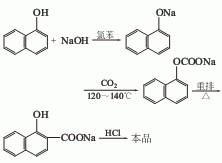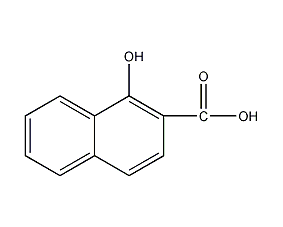1-Hydroxy-2-naphthoic acid


Structural formula
| Business number | 01WP |
|---|---|
| Molecular formula | C11H8O3 |
| Molecular weight | 188.18 |
| label |
1-Naphthol-2-carboxylic acid, 1,2-acid, 1,2 acid, 1-naphthol-2-carboxylic acid, 1-hydroxy-2-naphthoic acid, 1-hydroxy-beta-naphthoic acid, 1-Hydroxy-2-naphthoic acid, α-Hydroxynaphthoic acid, Aromatic carboxylic acids and their derivatives |
Numbering system
CAS number:86-48-6
MDL number:MFCD00003960
EINECS number:201-674-0
RTECS number:None
BRN number:974438
PubChem number:24846929
Physical property data
1. Character: white to reddish crystal
2. Density (g/mL, 25/4℃): Undetermined
3. Relative vapor density (g/ mL, air = 1): Undetermined
4. Melting point (ºC): 192, decomposes at 204~205.
5. Boiling point (ºC, normal pressure): Undetermined
6. Boiling point (ºC, 5.2kPa): Undetermined
7. Refractive index: Undetermined
8. Flash point (ºC): Undetermined
9. Specific rotation (º): Undetermined
10. Autoignition point or ignition Combustion temperature (ºC): Undetermined
11. Vapor pressure (kPa, 25ºC): Undetermined
12. Saturated vapor pressure (kPa, 60ºC): Undetermined
13. Heat of combustion (KJ/mol): Undetermined
14. Critical temperature (ºC): Undetermined
15. Critical pressure (KPa): Undetermined
16. Logarithmic value of oil-water (octanol/water) partition coefficient: Undetermined
17. Explosion upper limit (%, V/V): Undetermined
18. Lower explosion limit (%, V/V): Undetermined
19. Solubility: Soluble in ethanol, ether, benzene, chloroform and alkaline solution, slightly soluble in hot water , almost insoluble in cold water.
Toxicological data
Acute toxicity:
Main irritant effects:
On skin: Irritation to skin and mucous membranes.
On the eyes: effects of irritation.
Sensitization: No known sensitizing effects.
Ecological data
General remarks
Water hazard level 1 (German regulations) (self-assessment via list) This substance is slightly hazardous to water.
Do not allow undiluted or large amounts of product to come into contact with groundwater, waterways or sewage systems.
Do not discharge materials into the surrounding environment without government permission.
Molecular structure data
1. MooreEmissivity: 52.90
2. Molar volume (cm3/mol): 134.5
3. Isotonic specific volume (90.2K): 388.2
4. Surface tension (dyne/cm): 69.4
5. Polarizability (10-24cm3): 20.97
Compute chemical data
1. Reference value for hydrophobic parameter calculation (XlogP): None
2. Number of hydrogen bond donors: 2
3. Number of hydrogen bond acceptors: 3
4. Number of rotatable chemical bonds: 1
5. Number of tautomers: 3
6. Topological molecule polar surface area 57.5
7. Number of heavy atoms: 14
8. Surface charge: 0
9. Complexity: 227
10. Number of isotope atoms: 0
11. Determine the number of atomic stereocenters: 0
12. Uncertain number of atomic stereocenters: 0
13. Determine the number of chemical bond stereocenters: 0
14. Number of uncertain chemical bond stereocenters: 0
15. Number of covalent bond units: 1
Properties and stability
This product is toxic. Its physiological effects are similar to those of hydroxycarboxylic acid. The solvent chlorobenzene used in the production of this product is anesthetic and can irritate the skin; hydrochloric acid is a volatile gas that irritates the skin and mucous membranes and can easily cause pharyngitis. Labor protection should be strengthened during the production process, and operators should wear labor protection equipment.
Storage method
Packed in iron drums, 50kg per drum. It should be stored in a dry and ventilated place, away from sunlight, heat and moisture.
Synthesis method
Using 1-naphthol as raw material, in the solvent chlorobenzene, 1-naphthol sodium salt and carbon dioxide are carboxylated to prepare naphthyl carbonate sodium salt, and then molecular rearrangement is performed to obtain 1-hydroxy-2- Naphthoic acid sodium salt is then acidified with hydrochloric acid to prepare 1-hydroxy-2-naphthoic acid. Industrial first-grade product is white powder with content ≥98% and melting point above 186℃. Raw material consumption quota: 1-naphthol 1160kg/t, liquid alkali (30%) 940kg/t, carbon dioxide 500kg/t.

Purpose
Dye intermediates. Mainly used to prepare acid mordant dye blue, acid mordant dye green, etc. It is also a raw material for batteries and color film couplers.
